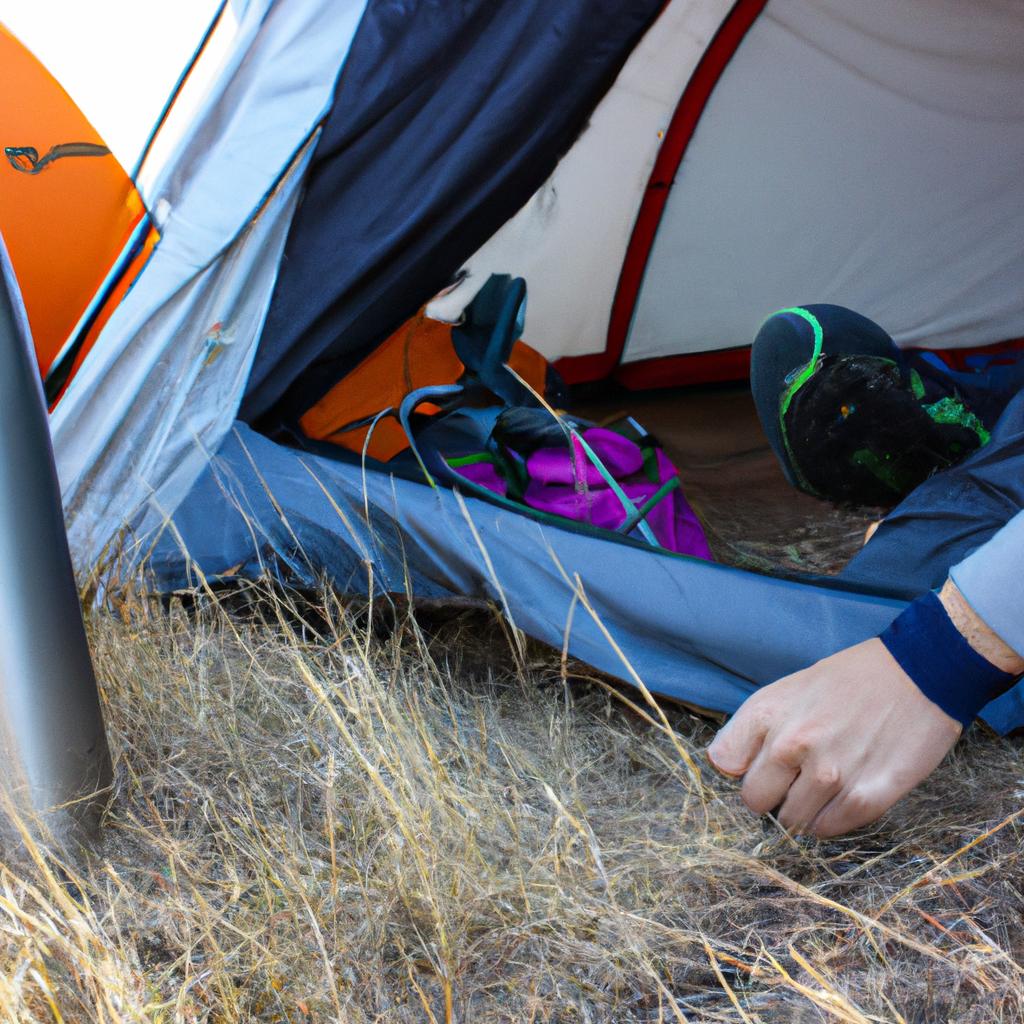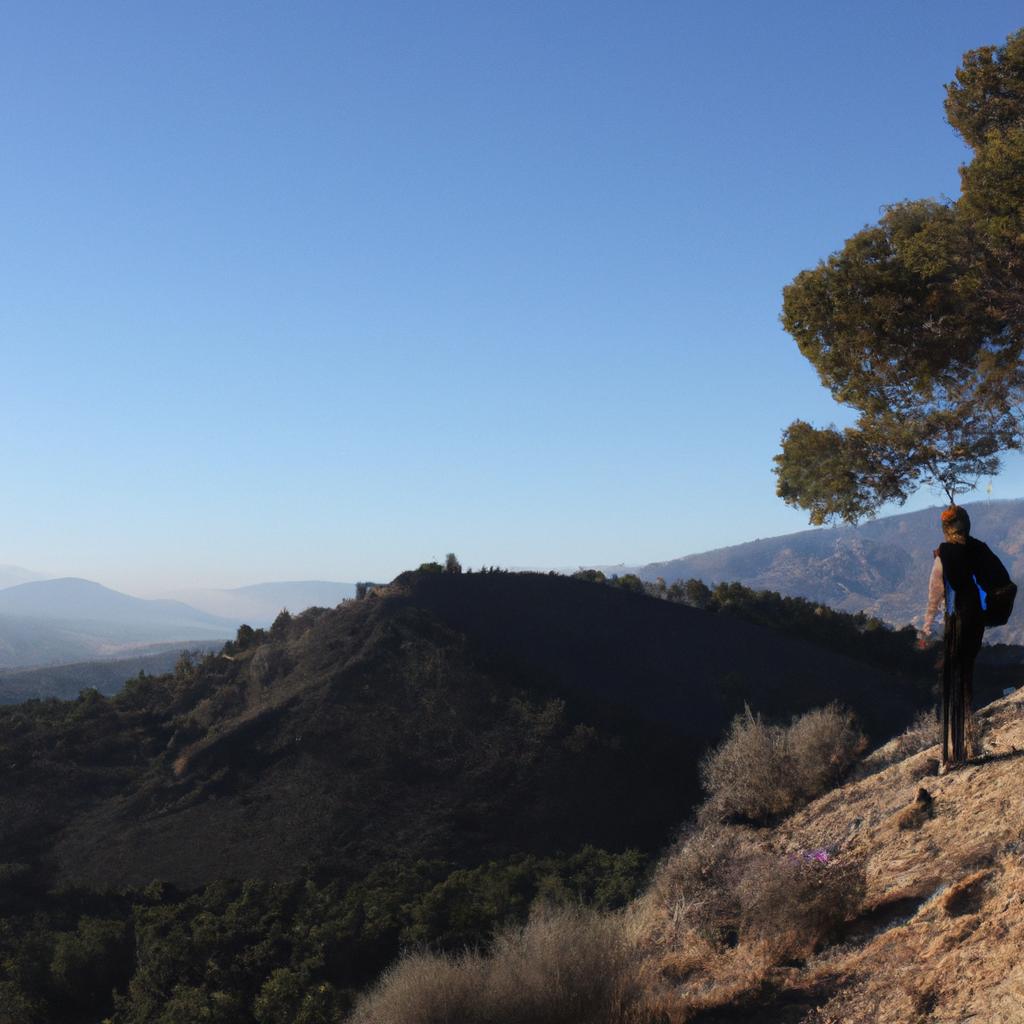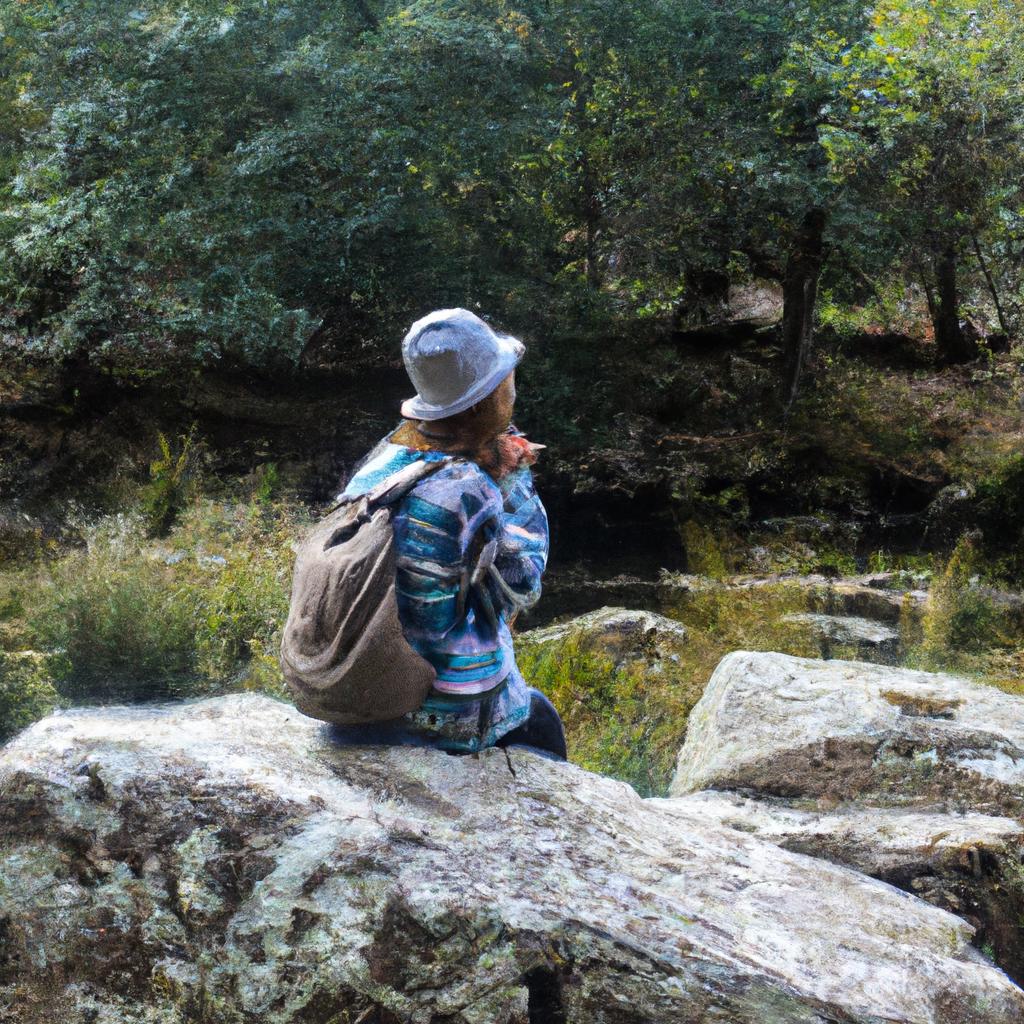Outdoor activities such as hiking and camping have become increasingly popular forms of recreation, offering individuals the opportunity to connect with nature and escape the confines of everyday life. However, engaging in these activities comes with inherent risks that must be acknowledged and addressed to ensure a safe and enjoyable experience. This article aims to explore the importance of outdoor safety in the context of travel recreation, specifically focusing on hiking and camping.
Consider the following scenario: A group of inexperienced hikers embarks on a day-long journey through rugged terrain. Excitement fills the air as they immerse themselves in picturesque landscapes, oblivious to the potential dangers that lie ahead. Suddenly, one member of the group slips on loose gravel near a steep edge, narrowly avoiding a serious accident. Instances like this serve as reminders that even seemingly harmless outings can quickly turn into perilous situations if proper precautions are not taken.
By examining common hazards encountered during hiking and camping expeditions, discussing essential safety measures to mitigate those risks, and highlighting relevant case studies or hypothetical scenarios where accidents could occur, readers will gain valuable knowledge necessary for ensuring their well-being while indulging in these thrilling outdoor pursuits.
Pre-trip planning and preparation
Imagine this scenario: Sarah, an avid hiker, decides to embark on a weekend camping trip in the wilderness. She packs her backpack with all the necessary essentials, excitedly heads out into nature, only to realize halfway through her journey that she forgot to check the weather forecast. As luck would have it, a sudden thunderstorm rolls in, leaving Sarah drenched and ill-prepared for the harsh elements.
This anecdote serves as a reminder of the importance of pre-trip planning and preparation when engaging in outdoor activities such as hiking and camping. Adequate preparation not only enhances safety but also contributes significantly to overall enjoyment during these recreational pursuits. By following a few key guidelines and taking appropriate precautions, individuals can ensure a smooth and worry-free experience.
Firstly, conducting thorough research about the intended destination is crucial. Familiarize yourself with the terrain, wildlife presence, potential hazards like poisonous plants or dangerous animals, as well as any specific regulations or permits required for access. This knowledge empowers hikers and campers to make informed decisions regarding their route choices and ensures compliance with local rules.
Secondly, creating a detailed itinerary is essential before setting off on any adventure. Outline your planned departure time, expected arrival times at various checkpoints along the way, estimated duration of each activity (such as hikes), and contingency plans if unforeseen circumstances arise. Sharing this information with someone reliable who is not partaking in the excursion adds an extra layer of safety by enabling timely search-and-rescue efforts should you encounter difficulties.
Lastly, prioritize personal safety by packing appropriate gear and supplies tailored to your outing’s demands. A comprehensive checklist may include items such as navigation tools (maps or GPS devices), first aid kits equipped with essentials like bandages and antiseptic creams, sufficient water supply alongside filtration methods if needed for longer trips, nutritionally dense food options suitable for outdoor consumption (e.g., energy bars), and clothing suitable for the expected weather conditions. This brings us to the next section, where we will delve deeper into essential gear and equipment.
In summary, pre-trip planning and preparation play a pivotal role in ensuring safe and enjoyable outdoor experiences. By conducting thorough research, creating detailed itineraries, and packing appropriate supplies, hikers and campers can mitigate potential risks while maximizing their enjoyment of nature’s wonders. With these measures in place, adventurers can embark on their journeys confidently, ready to embrace the challenges that lie ahead.
Transitioning seamlessly into our subsequent discussion about “Essential gear and equipment,” let us now explore the items necessary for an optimally prepared excursion.
Essential gear and equipment
Section H2: Essential gear and equipment
After thoroughly planning and preparing for your outdoor adventure, it is crucial to equip yourself with the necessary gear and equipment. Let’s take a closer look at what you’ll need before heading out into the wilderness.
Imagine this scenario: You’ve embarked on a multi-day hiking trip in the rugged mountains. As night falls, temperatures drop significantly, making it essential to have appropriate gear to stay warm and protected. One example of indispensable equipment is a high-quality sleeping bag designed for cold weather conditions, ensuring comfort during chilly nights spent under the stars.
To ensure your safety and enjoyment while exploring nature, here are some essential items that should be part of any hiker or camper’s arsenal:
- A reliable backpack: Choose one that fits well and has enough capacity to carry all your essentials.
- Proper footwear: Invest in sturdy hiking boots or shoes that provide ankle support and traction on various terrains.
- Navigation tools: Carry a compass, map, or GPS device to help you navigate through unfamiliar trails.
- First aid kit: Accidents can happen even in the great outdoors; make sure your first aid kit contains supplies such as bandages, antiseptic ointment, and pain relievers.
Now let’s delve deeper into the importance of having these essential items by examining their benefits through an emotional lens:
| Gear/Equipment | Emotional Benefit |
|---|---|
| Reliable backpack | Sense of security knowing all necessities are within reach |
| Proper footwear | Confidence in tackling challenging terrains without discomfort |
| Navigation tools | Peace of mind from avoiding getting lost or disoriented |
| First aid kit | Assurance that minor injuries can be promptly treated |
By considering both practicality and emotional aspects when selecting your gear, you enhance not only your physical preparedness but also your mental resilience throughout your journey.
Equipped with proper knowledge about pre-trip planning and preparation as well as necessary gear and equipment, you are now ready to move on to the next step: choosing a suitable hiking or camping location. This decision plays a crucial role in ensuring an enjoyable and safe outdoor experience, so let’s explore it further together.
Choosing a suitable hiking or camping location
Imagine this scenario: Sarah, an avid nature enthusiast, decides to embark on a hiking trip in the picturesque mountains of her region. She carefully packs her essential gear and equipment, ensuring she has everything she needs for a safe and enjoyable adventure. But before setting off into the wilderness, Sarah must consider another crucial aspect – choosing a suitable hiking or camping location.
When selecting a hiking or camping site, there are several factors that require careful consideration:
-
Accessibility: The accessibility of the location is an important factor to ponder upon. How far is it from your starting point? Is there reliable transportation available? Consider these questions as they impact travel time, convenience, and ease of reaching your destination.
-
Terrain and Difficulty Level: Different locations offer varying levels of difficulty in terms of terrain and trail conditions. Some trails may be more challenging with steep ascents or rugged paths, while others might provide smoother surfaces for beginners or families with young children. Assessing your physical abilities and experience level will help determine the most appropriate location.
-
Weather Conditions: Weather can play a significant role in determining the suitability of a hiking or camping spot. Check weather forecasts ahead of time to ensure you choose a location where the expected conditions align with your comfort level and safety requirements.
-
Facilities and Amenities: It’s essential to consider what facilities are available at potential sites. Are there restroom facilities, water sources, or designated campsites? Depending on individual preferences and necessities, access to such amenities can greatly enhance the overall experience.
To illustrate how these factors come together when planning outdoor activities, refer to the following table:
| Location | Accessibility | Terrain | Weather |
|---|---|---|---|
| Mountain A | Easily accessible | Challenging | Variable |
| Lake B | Remote | Moderate | Mild |
| Forest C | Moderate access | Gentle slopes | Stable conditions |
By considering these factors and assessing the various locations available, individuals can make informed decisions that align with their preferences, skill levels, and safety requirements. Remember, thorough planning ensures a more enjoyable and secure outdoor experience.
Transitioning into the subsequent section on “Safety precautions and emergency procedures,” it is essential to be prepared for unforeseen events while exploring nature’s wonders. Understanding how to handle emergencies will provide an added layer of security to your trip.
Safety precautions and emergency procedures
Choosing a suitable hiking or camping location is crucial for ensuring a safe and enjoyable outdoor experience. Let’s take the case of Sarah, an experienced hiker who decided to embark on a weekend camping trip in the mountains. She selected a remote location with breathtaking views but failed to consider some important factors that would impact her safety.
Firstly, it is essential to assess the difficulty level of the chosen hiking trail or camping site. Sarah underestimated the steepness and rugged terrain of her selected path, leading to difficulties navigating certain sections. This oversight resulted in fatigue and increased risk of accidents. It is vital to research and understand the level of physical fitness required for each location beforehand.
Secondly, one should consider environmental conditions when selecting a hiking or camping spot. Despite checking weather forecasts prior to her trip, Sarah encountered unexpected rainstorms during her hike. Her lack of preparation for inclement weather led to discomfort and heightened risks such as slippery trails and potential hypothermia. Always be mindful of changing weather patterns and pack appropriate gear accordingly.
Lastly, assessing wildlife activity in an area is critical for personal safety while engaging in outdoor activities. In Sarah’s case, she encountered a bear near her campsite due to inadequate knowledge about local wildlife behavior and precautions. Being aware of potential encounters with animals can help prevent dangerous situations by taking necessary preventive measures such as storing food properly away from sleeping areas.
To evoke an emotional response regarding outdoor safety while traveling for recreation, keep these points in mind:
- Do thorough research on the difficulty level of your preferred location.
- Stay informed about changing weather conditions before embarking on your journey.
- Understand the behavior of local wildlife species you may encounter.
- Prepare adequately by packing essential gear like raincoats, extra layers, and proper storage containers for food.
Consider this table showcasing examples of common hazards faced during hiking or camping trips:
| Hazard | Risk | Preventive Measures |
|---|---|---|
| Uneven terrain | Tripping and falling | Wear appropriate footwear |
| Poisonous plants | Allergic reactions, rashes | Familiarize yourself with local flora |
| Inadequate water supply | Dehydration | Carry enough water |
| Improper fire management | Wildfires | Follow park regulations for fires |
In conclusion, choosing a suitable hiking or camping location involves careful consideration of several factors. Assessing the difficulty level, environmental conditions, and wildlife activity can significantly impact your safety during outdoor travels. By understanding these aspects and taking necessary precautions, you can ensure a memorable and secure experience in nature.
Moving forward to the next section on wildlife encounters and how to respond, let’s explore strategies for handling unexpected interactions with animals while enjoying the outdoors.
Wildlife encounters and how to respond
Building on the importance of safety precautions and emergency procedures, understanding how to respond during wildlife encounters is equally crucial when engaging in outdoor activities such as hiking and camping. Let us now explore some key guidelines for handling encounters with wildlife.
Wildlife Encounters and How to Respond
One example that highlights the significance of proper response to a wildlife encounter involves a hiker named Sarah who was exploring a national park. While traversing through a dense forest, she suddenly encountered a bear. Feeling frightened and unsure about what to do, her lack of knowledge put both herself and the bear at risk. This scenario emphasizes the need for individuals engaging in outdoor activities to be well-informed about wildlife encounters and appropriate responses.
To ensure your safety when encountering wildlife while hiking or camping, consider the following guidelines:
- Maintain distance: Keep a safe distance from any wild animal you come across, especially large mammals like bears or moose.
- Remain calm: If you find yourself face-to-face with an animal, try not to panic. Stay calm and avoid sudden movements that may startle or provoke them.
- Make noise: When walking through areas known for wildlife activity, it is helpful to make noise by talking loudly, clapping hands, or using bells attached to backpacks. This alerts animals to your presence and reduces the likelihood of surprising them.
- Use deterrents responsibly: Carry bear spray or other deterrents recommended for specific regions if necessary. Ensure you understand how they work before venturing into areas where their use might be required.
In addition to these guidelines, being aware of different species’ behaviors can be valuable information while navigating the wilderness safely. The table below illustrates common types of North American wildlife encounters along with recommended responses:
| Wildlife Species | Recommended Response |
|---|---|
| Bear | Speak calmly and firmly; back away slowly without turning your back |
| Moose | Give them plenty of space; avoid sudden movements or loud noises |
| Coyote | Make yourself appear larger, yell loudly, and throw objects near them |
| Snake | Back away slowly without making any sudden moves |
By adhering to these guidelines and understanding how to respond appropriately during wildlife encounters, you can minimize potential risks while enjoying the beauty of nature. In doing so, you contribute to your own safety as well as the preservation of wildlife habitats.
As we delve into the importance of outdoor safety practices, it is crucial to consider not only our personal well-being but also that of the environment. Next, we will explore Leave No Trace principles and environmental stewardship.
Leave No Trace principles and environmental stewardship
Section H2: Leave No Trace Principles and Environmental Stewardship
When venturing into the great outdoors, it is essential to be mindful of our impact on the environment. By following Leave No Trace principles and practicing environmental stewardship, we can ensure that future generations will have a chance to experience the beauty and serenity of nature. In this section, we will explore these principles and discuss how they contribute to outdoor safety.
Leave No Trace (LNT) is a set of guidelines designed to minimize human impact on natural spaces. Let’s consider an example scenario: imagine you are hiking through a pristine forest. Suddenly, you come across a small campsite where someone has left behind trash and abandoned their fire pit without properly extinguishing it. This not only detracts from the natural aesthetic but also poses potential dangers for wildlife and other visitors. Following LNT principles would involve packing out all trash, thoroughly extinguishing fires, and leaving the area as undisturbed as possible.
To further understand the importance of LNT principles in promoting outdoor safety, let us examine four key practices:
-
Plan Ahead and Prepare:
- Research your destination before heading out.
- Pack necessary supplies while considering weight restrictions.
- Familiarize yourself with local regulations regarding camping or hiking permits.
-
Dispose of Waste Properly:
- Carry out all trash and dispose of it responsibly.
- Use designated restroom facilities when available; otherwise, bury waste at least 200 feet away from water sources.
- Pack out toilet paper or hygiene products by double bagging them.
-
Minimize Campfire Impacts:
- Check if campfires are allowed in your chosen location.
- If permitted, use established fire rings or pits whenever possible.
- Ensure fires are fully extinguished using water or dirt before leaving the site.
-
Respect Wildlife:
- Observe animals from a distance and never feed them.
- Store food in bear-resistant containers or hang it at least 10 feet above the ground.
- Avoid approaching nesting or denning sites, as this can cause unnecessary stress to wildlife.
By adhering to these practices, we foster environmental stewardship and contribute to maintaining the delicate balance of our natural ecosystems. It is crucial that we recognize our role as responsible stewards of the environment, ensuring its preservation for future generations to enjoy.
| Leave No Trace Principles | How They Promote Outdoor Safety |
|---|---|
| Plan Ahead and Prepare | Ensures you are equipped for potential challenges |
| Dispose of Waste Properly | Keeps campgrounds clean and free from hazards |
| Minimize Campfire Impacts | Reduces risk of wildfires |
| Respect Wildlife | Prevents dangerous encounters with animals |
In summary, following Leave No Trace principles supports outdoor safety by minimizing human impact on natural spaces. By planning ahead, properly disposing of waste, respecting fire regulations, and treating wildlife with care, we can ensure that our adventures leave no lasting negative effects on the environment. Let us strive to be conscientious stewards so that future generations may also revel in nature’s wonders without compromising their safety or the integrity of these wild places.




